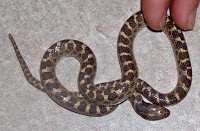 CAUTION: rattlesnakes are venomous and their bites can be dangerous to people. There is much lore and misinformation about rattlesnakes and their bites; please review this link Living with Rattlesnakes for more information about safety around rattlesnakes. The bottom line: don't pick up any snake that might be a rattlesnake, and when you are outdoors in rattlesnake country (most of California), be careful where you place your hands and feet.
CAUTION: rattlesnakes are venomous and their bites can be dangerous to people. There is much lore and misinformation about rattlesnakes and their bites; please review this link Living with Rattlesnakes for more information about safety around rattlesnakes. The bottom line: don't pick up any snake that might be a rattlesnake, and when you are outdoors in rattlesnake country (most of California), be careful where you place your hands and feet.<--- note="" span="" the="" two=""> holes on each side of the rattle- snake's head: the inner nostril and the outer heat- sensing pit.
Behind and in the garage and barn, under the picnic table, at the foot of my kitchen steps, next to a creek, on a cow carcass and sunning with art. These are all places I have seen rattlesnakes on the Dipper Ranch.
Sometimes I worry that there is a den of rattlesnakes under the barn. And yet all 11 (eleven!) times I have seen a rattlesnake in the past 14 months, only one has been an adult size, and only two have gotten into strike pose and rattled and only after a commotion as several people panicked. No person, pet or livestock have been bitten. One large rattler was killed and I support that decision under the circumstances.

Rattlesnakes are the only snake native to California that have venom potentially harmful to humans. The small-sized California nightsnake is mildly venomous with just enough venom to subdue a frog or lizard but not enough to hurt a human. The only species of rattlesnake in northern California is the northern Pacific rattlesnake (Crotalus oreganus oreganus). Southern California has 8 rattlesnake species and the southwestern deserts of the US have 15 rattlesnake species.
The basic appearance of rattlesnakes is a heavy body with brown blotches. The head is triangular shaped due to venom pits in its 'cheeks', the neck is comparatively narrow below the jaw and the tail is blunt with rattles. In my observations, a single row of white scales surrounds each brown blotch on our local northern Pacific rattlesnakes.
 The end of the tail of rattlesnakes is blunt with a series of yellowish, hard segments which are the rattles. Young rattlesnakes may have only one small segment which might not be obvious, but the tip of the tail will still be distinctly blunt, yellow and out of a different material than the rest of the snake's body. I often do not see the tail end of a rattlesnake, especially when they are resting in a coiled position, so do not assume a snake is not a rattler just because the rattles are not obvious. You need to have a good view of the tail end to make this call.
The end of the tail of rattlesnakes is blunt with a series of yellowish, hard segments which are the rattles. Young rattlesnakes may have only one small segment which might not be obvious, but the tip of the tail will still be distinctly blunt, yellow and out of a different material than the rest of the snake's body. I often do not see the tail end of a rattlesnake, especially when they are resting in a coiled position, so do not assume a snake is not a rattler just because the rattles are not obvious. You need to have a good view of the tail end to make this call.RATTLESNAKE LOOK-A-LIKES: Other snakes with brown blotches in central coastal California that might be confused with rattlesnakes are gopher snakes, nightsnakes and juvenile racer snakes. None of these have rattles on the tail. Instead, they have sharply pointed tails. You may not always be able to see the tail on a snake, so move cautiously away from brown-blotched snakes if you can't see the tail. On the other hand, these other snakes should not immediately be killed just because they look like rattlers.
Here are a few photos for comparison, but check the better photos at the California Herps website to become familiar with the distinct differences between these snakes.
 Gopher snakes are large. They have a pointed end to their tail, but if they nervously twitch their tail in a pile of dry leaves, it may sound like rattling. When gopher snakes are threatened, they sometimes flatten their head on the ground and the outline takes on a general diamond shape, however, the neck does not greatly narrow below the jaw as with rattlesnakes.
Gopher snakes are large. They have a pointed end to their tail, but if they nervously twitch their tail in a pile of dry leaves, it may sound like rattling. When gopher snakes are threatened, they sometimes flatten their head on the ground and the outline takes on a general diamond shape, however, the neck does not greatly narrow below the jaw as with rattlesnakes. California nightsnakes are small, have bright, coppery-gold eyes with a vertical slit, and a larger pair of brown blotches on the side of their head that merge together on their upper neck. The rest of the body has separate brown blotches. Pointed tail.
California nightsnakes are small, have bright, coppery-gold eyes with a vertical slit, and a larger pair of brown blotches on the side of their head that merge together on their upper neck. The rest of the body has separate brown blotches. Pointed tail.
Juvenile yellow-bellied racer snakes have blotchy coloration unlike the adult racers, but they are slender with large, round, dark eyes.
